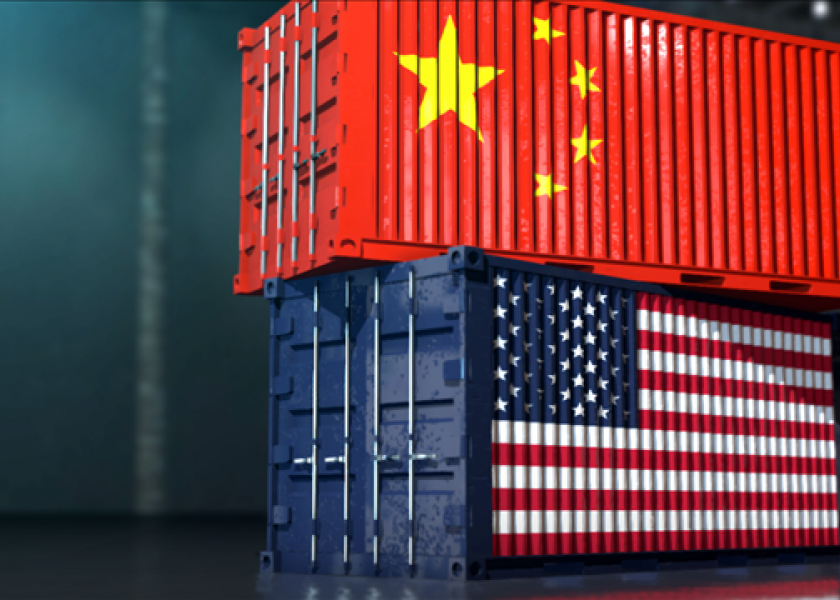U.S. Trade Tactics to Evolve with China's Infrastructure Plan

Agricultural Outlook Forum 2022 took flight last Thursday with early morning sessions on trade, carried on Friday when USDA Secretary Tom Vilsack and U.S. Trade Representative Katherine Tai brought agricultural America up to speed on current trade deals with China, as well as what’s in the works.
Where We Are
With the U.S. on the back end of COVID-19 and the conflict between Russia and Ukraine unraveling, Tai says her office is currently focused on three themes: resilience, sustainability and competition.
“We’re working intensively around the development of more resilience and trust in the global economy by figuring out new supply chains that can withstand geopolitical pressures that are rising,” Tai says. “We cannot make decisions for China, but we will continue to press the impacts of its policies on our producers.”
According to Tai, China is many things to the U.S.—rival, competitor and partner. Accountability is top of mind when trying to even the playing field with China, but she says these discussions “have gotten more difficult over time.”
Where We Were
Elizabeth Economy, senior advisor for China in the U.S. Department of Commerce, says China has developed its own infrastructure program, the Belt and Road Initiative, that acts as a major chess piece in the country’s economic puzzle.
She says the Initiative is an expansion of China’s 1990s policy, aimed at connecting its lesser developed regions to external markets through economic “silk road” avenues:
• Hard Silk Road—ports and railroads
• Digital Silk Road—fiber optic cables and e-commerce
• Health Silk Road—medical devices and traditional Chinese medicine
Beyond the economic elements, Economy says there is a political component to the Belt and Road Initiative that started out enthusiastically but quickly turned sour when countries tied to the legislation saw the full scope of the plan.
“Many countries have infrastructure needs that other lenders or donors couldn’t or wouldn’t meet that China fulfilled,” Economy says. “A lot of these Belt and Road projects are done for geostrategic reasons. Even the Chinese government is concerned about the number of countries now coming back to them saying, ‘Hey, we’d like to renegotiate the terms of this agreement.’”
Tai’s office previously initiated conversations with China regarding the Phase One agreement. However, 2021 data that has been released in recent weeks shows continued uneven shortfalls, creating “difficulties” in trade talks.
China’s investment in the Belt and Road legislation peaked in 2016 and has since been on a steady decline. Economy believes China’s changing level of commitment to its “grand scale” infrastructure plan is penning a complete digital refocus for China in coming years, morphing other countries’ interests in China.
Where We’re Heading
Trade negotiations have played out between the U.S. in China in recent months, but Tai says that's not the only tool her team has in their toolbox. She says negotiations are held internally and externally, while Trade and Investment Framework Agreements (TIFA), or trade pacts, are developed.
"One of the most important types of engagement frameworks are the TIFA—foundational agreements that are there to enhance collaboration and cooperation." says Tai. "A lot of the gains that we've made over the course of the last year in the Indo-Pacific have come out of our agenda to intensify our TIFA engagement. This is our opportunity for innovation in terms of how we bring different ideas and different initiatives to our trading partners."
At the Forum, Vilsack hinted China may look to join the Comprehensive and Progressive Trans-Pacific Partnership (CPTPP) but will not qualify as it cannot meet the agreement’s standards.
According to Vilsack, the Biden administration also is not ready to join CPTPP until public trust is reestablished and trade barriers are removed.
Jim Wiesemeyer, Pro Farmer Washington policy analyst believes Biden isn’t looking to get back into the CPTPP as this time because “they don’t have the votes, nor the trade promotion authority.”
“When asked, I tell farmers the administration has to be strategizing how they’re going to dance around this changing trade policy focus because of the war’s impact on China,” says Wiesemeyer. “I think they’re looking at one-on-one agreements, which was the approach that Trump preferred—bilateral as opposed to multilateral.”
As for China, Economy says the country tends to pursue its own “narrow” authoritarian interests that it then pitches to other authoritarian countries. She sees growing concern in the security threat that’s posed by China.
“Authoritarian leaning leaders often appreciate China’s effort to sell them surveillance technology or training them on how to do real-time censorship of the internet,” says Economy. “I think the picture really is a mixed one in terms of the global reaction, but very few countries would say that China has proved itself as truly ready to lead on the global stage.”
USDA Foreign Agricultural Service (FAS) Administrator Dan Whitley says, “One day, China could just wake up and for whatever reason say, ‘Hey, you know, we've kind of had enough of this,’” and shut off U.S. agricultural products to “send a signal to the American agricultural sector or the U.S. government.”







